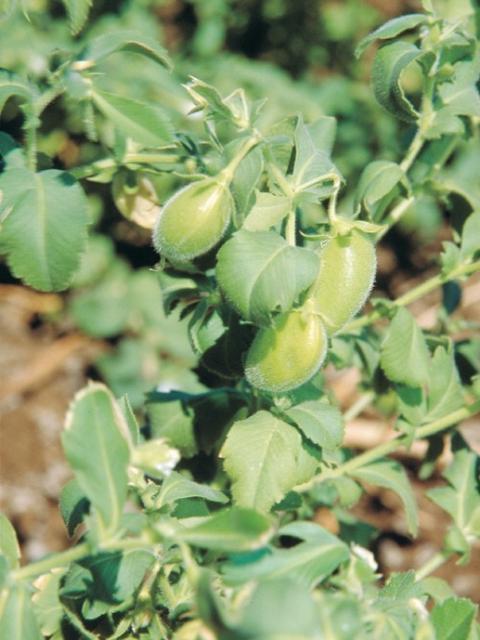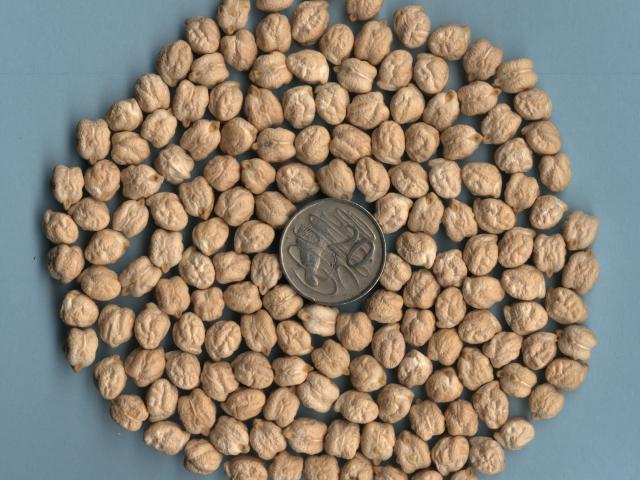Climate
Chickpeas are well adapted to a broad range of environments in Australia, extending from the tropical ORIA, to sub-tropical Queensland and northern New South Wales, and to Mediterranean type environments of southern Australia. Growing conditions vary substantially between these regions, requiring a range of varieties with specific characteristics and adaptation.
Chickpeas are more tolerant to high temperatures during flowering than many other cool-season grain legumes. The optimum temperatures for chickpea production range from 21-29oC during the day and from 15-20oC at night. The ORIA has a semi-arid tropical climate with an average annual rainfall of 787mm. The wet season extends from December to the end of March. Chickpeas, along with most other crops, are sown in the dry season between May and October under irrigation. Mean maximum temperatures range from 31oC in June to 39oC in November, while mean minimum temperatures range from 14oC in July to 25oC in December. Hence, the ORIA provides excellent conditions for the production of specific high value chickpea varieties adapted to sub-tropical conditions under irrigation.
Soils
Chickpeas prefer well-drained, neutral to alkaline soils with a pH greater than 5 (in calcium chloride). In the ORIA, chickpeas are most suited to the Cununurra clay (black soil), but are also grown on Ord sandy loams (red alluvial soil). Both of these soil-types have moderately alkaline topsoil (pH 7.5–8.0) and highly alkaline sub-soil (pH >8.0). When wet the Cununurra clay surface swells and the soil becomes very sticky and generally impervious to water. Because of the potential waterlogging problems on this soil type chickpeas and other crops are grown on raised beds.
Raised beds
For chickpeas it is recommended that bed height is at least 0.16 m. Sufficient bed height is necessary to allow drainage of water when irrigating and to prevent waterlogging. Kabuli chickpea seed is susceptible to mould and fungal attack in the soil, particularly under waterlogged conditions, hence it is important to monitor soil moisture prior to sowing. Bed height generally needs to be higher where bays are long (>300m) or have a low grade to improve drainage.
Varieties
Kimberley Large and Macarena are the two varieties of chickpea currently grown in the ORIA. They are early flowering (40-42 days after sowing), large seeded (>50 g/100 seeds) and have a white seed coat colour. In yield evaluation trials conducted in the ORIA, Kimberley Large produced on average six per cent greater seed yield and a higher proportion of large seed (greater than 10 mm diameter) than Macarena Sowing time
Figure 1. Pods of Kabuli Chickpea
Sowing time
The ideal time for planting chickpea in the ORIA is early to mid-May. This allows growth and development to occur at optimum temperature and day length conditions, and the crop to mature by September/October, prior to the commencement of the wet season. Delayed sowing reduces seed yield significantly, because flower and pod development coincides with sub-optimal temperatures later in the season.
Figure 2. Dry seeds of Kabuli Chickpea.
Sowing rate
Kabuli chickpeas in the ORIA are generally sown in two rows per bed with an inter row spacing of 0.86 m. A sowing rate of 100-110 kg/ha will produce a plant density of approximately 15 plants per metre (17 plants/m2), assuming a mean seed weight of 0.50g/seed and 80% germination. Sowing rate can be calculated using the following formula:
Sowing rate (kg/ha) = 17 plants/m2 x seed weight (g) x 1000 ÷ germination percentage
For example: Sowing rate (kg/ha) = 17 x 0.50 x 1000 ÷ 80 = 102
Sowing depth
The depth of sowing will affect the emergence and establishment of the crop. Chickpeas, like most other cool season grain legumes, have hypogeal emergence, so the cotyledon remains where the seed is sown and only the shoot emerges from the soil. In contrast, soy beans and lupins have epigeal emergence and the cotyledons are pushed up through the soil. Species with hypogeal emergence can generally been sown deeper with no detrimental effect on establishment. The optimum depth of sowing for chickpea is 5-8 cm. Sowing at this depth improves emergence and promotes lateral root development.
Weed management
Chickpeas are relatively poor competitors with weeds, and hence, weed management prior to sowing using cultivation and broad-spectrum herbicides is desirable. Attention needs to given to controlling weeds during the rainy season in paddocks intended for growing chickpeas. Generally, in-crop herbicide application is not a common practice for weed management in the ORIA. It is advisable to follow a non-legume crop which has not been sprayed with herbicides that are residual.
Seed treatment
Kabuli chickpeas have a relatively thin seed coat, which make them vulnerable to mechanical damage during harvest and handling, and lack seed-protecting phenolic compounds in their seed coat. Therefore, application of fungicides to seed prior to sowing is an important practice in kabuli chickpea production.
P-Pickle T fungicide applied to the seed is effective in reducing the infection of seed transmitted fungal diseases such as Botrytis Grey Mould (BGM), Macrophomina spp., Fusarium spp. and Pythium spp. Field trials conducted in Kununurra in 1998 and 1999 have confirmed that P-Pickle T is currently the most effective and economical fungicide for seed dressing. P-Pickle T is a mixture of Thiram and Thiabendazole and can be applied at a rate of 200 mL of product per 100 kg of seed.
Inoculation
Chickpeas must be inoculated with Group N (strain CC1192) for maximum nitrogen fixation. In general, it is good practice to inoculate the seed, regardless of the cropping history. Inoculants are available in three different carriers (a) peat (b) freeze dried powders, and (c) granular. Take care to adhere to instruction and expiry information on the label of the product because all forms of inoculant carry live cells of bacteria which must be correctly stored and used within specific periods.
The cost of inoculation can vary depending on the product. Peat-slurry and water furrow injection is the cheapest form of inoculation but there are additional costs in time and labour to consider. Granules are more expensive but can be easier to use and offer greater flexibility for sowing operations.
Fungicides, such as P-Pickle T, applied to the seed are toxic to the rhizobia in the inoculum. If using peat-slurry inoculation, it is important to inoculate the seed as close as possible to the time of sowing to maximise rhizobia survival. Peat inoculants applied at higher rates than recommended can increase rhizobia survival. Care must also be taken with water furrow injection of freeze dried powder or peat. The tank must be thoroughly cleaned of residues and clean water used, preferably rain water. Recent experimental plantings of chickpeas have shown superior nodulation and grain yield with granular inoculants applied at double the recommended rate.


